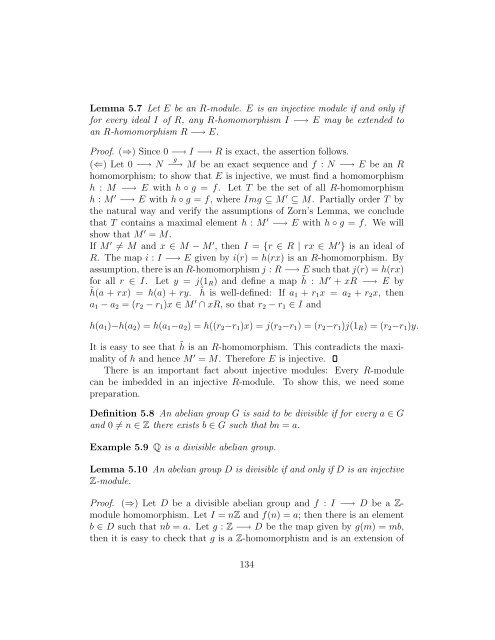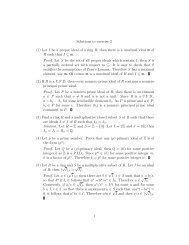Topics in algebra Chapter IV: Commutative rings and modules I - 1
Topics in algebra Chapter IV: Commutative rings and modules I - 1
Topics in algebra Chapter IV: Commutative rings and modules I - 1
You also want an ePaper? Increase the reach of your titles
YUMPU automatically turns print PDFs into web optimized ePapers that Google loves.
Lemma 5.7 Let E be an R-module. E is an <strong>in</strong>jective module if <strong>and</strong> only if<br />
for every ideal I of R, any R-homomorphism I −→ E may be extended to<br />
an R-homomorphism R −→ E.<br />
Proof. (⇒) S<strong>in</strong>ce 0 −→ I −→ R is exact, the assertion follows.<br />
(⇐) Let 0 −→ N g<br />
−→ M be an exact sequence <strong>and</strong> f : N −→ E be an R<br />
homomorphism; to show that E is <strong>in</strong>jective, we must f<strong>in</strong>d a homomorphism<br />
h : M −→ E with h ◦ g = f. Let T be the set of all R-homomorphism<br />
h : M ′ −→ E with h ◦ g = f, where Img ⊆ M ′ ⊆ M. Partially order T by<br />
the natural way <strong>and</strong> verify the assumptions of Zorn’s Lemma, we conclude<br />
that T conta<strong>in</strong>s a maximal element h : M ′ −→ E with h ◦ g = f. We will<br />
show that M ′ = M.<br />
If M ′ = M <strong>and</strong> x ∈ M − M ′ , then I = {r ∈ R | rx ∈ M ′ } is an ideal of<br />
R. The map i : I −→ E given by i(r) = h(rx) is an R-homomorphism. By<br />
assumption, there is an R-homomorphism j : R −→ E such that j(r) = h(rx)<br />
for all r ∈ I. Let y = j(1R) <strong>and</strong> def<strong>in</strong>e a map ˜ h : M ′ + xR −→ E by<br />
˜h(a + rx) = h(a) + ry. ˜ h is well-def<strong>in</strong>ed: If a1 + r1x = a2 + r2x, then<br />
a1 − a2 = (r2 − r1)x ∈ M ′ ∩ xR, so that r2 − r1 ∈ I <strong>and</strong><br />
h(a1)−h(a2) = h(a1−a2) = h((r2−r1)x) = j(r2−r1) = (r2−r1)j(1R) = (r2−r1)y.<br />
It is easy to see that ˜ h is an R-homomorphism. This contradicts the maximality<br />
of h <strong>and</strong> hence M ′ = M. Therefore E is <strong>in</strong>jective.<br />
There is an important fact about <strong>in</strong>jective <strong>modules</strong>: Every R-module<br />
can be imbedded <strong>in</strong> an <strong>in</strong>jective R-module. To show this, we need some<br />
preparation.<br />
Def<strong>in</strong>ition 5.8 An abelian group G is said to be divisible if for every a ∈ G<br />
<strong>and</strong> 0 = n ∈ Z there exists b ∈ G such that bn = a.<br />
Example 5.9 Q is a divisible abelian group.<br />
Lemma 5.10 An abelian group D is divisible if <strong>and</strong> only if D is an <strong>in</strong>jective<br />
Z-module.<br />
Proof. (⇒) Let D be a divisible abelian group <strong>and</strong> f : I −→ D be a Zmodule<br />
homomorphism. Let I = nZ <strong>and</strong> f(n) = a; then there is an element<br />
b ∈ D such that nb = a. Let g : Z −→ D be the map given by g(m) = mb,<br />
then it is easy to check that g is a Z-homomorphism <strong>and</strong> is an extension of<br />
134



